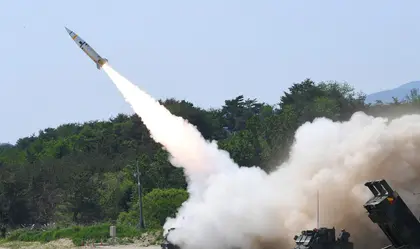Kyiv used US-supplied ATACMS missiles secretly deployed to Ukraine in a devastating overnight attack on Russian airfields, President Zelensky has confirmed.
In a mission dubbed "Operation Dragonfly," Ukraine's special forces said on Tuesday they had attacked airfields in southern Berdyansk and eastern Luhansk and had destroyed nine helicopters, an air defense launcher, and an ammunition warehouse.
JOIN US ON TELEGRAM
Follow our coverage of the war on the @Kyivpost_official.
The weapons used in the attack were not disclosed but within hours of the attacks, images began appearing on social media purporting to show the remnants of ATACMS munitions at the strike locations.
#Ukraine: Well, something extraordinary happened- the remains of M39 missiles (Made in 1996 and 1997) of the MGM-140A ATACMS Block I system used by Ukrainian forces against Berdyansk AB.
— 🇺🇦 Ukraine Weapons Tracker (@UAWeapons) October 17, 2023
This variant has a range of ~165km, inertial guidance, and carries 950 M74 submunitions. pic.twitter.com/AJQPC1WM2Q
Neither Kyiv nor Washington initially confirmed the long-range missiles were used but the Wall Street Journal on Tuesday evening reported: “Ukraine launched ATACMS missiles at Russian forces on Tuesday, marking the first time that the US-provided weapons have been used in the conflict in Ukraine.
“A small number of the missiles have been secretly sent to Ukraine in recent days, where they will augment Kyiv’s capability to carry out long-range strikes at Russian forces during an important stage of its counteroffensive, according to people familiar with the matter.”
President Zelensky later confirmed the report.
Ukraine has since the first days of the invasion repeatedly asked Washington for the ATACMS tactical ballistic missile, a weapon designed for American HIMARS launchers already in AFU operation, and ranging out to 500 km.

‘Wild Hornets’ Latest Development Will ‘Sting’ Russian Shahed Drones
The US has dragged its feet on a possible ATACMS transfer on grounds that American delivery of a ballistic missile system to Ukraine could trigger Kremlin aggression.
US-delivered HIMARS precision-guided rockets, thus far the most effective and destructive long-range weapon in AFU use, and thanks to overhead-burst warheads and high accuracy, one of the AFU’s go-to weapons for airfield strikes, have a maximum range of 80 km.
Ukraine’s domestically-produced Vilkha rocket has a rated range of 130 km, but thus far in the war, Kyiv has been unable to manufacture the munition in quantity.
Ukraine at the start of the war also had limited stocks of Tochka-U ballistic missiles, but reserves of that weapon are likely exhausted, military analysts have said.
What exactly is an ATACMS?
ATACMS (pronounced “attack’ems”) is a tactical ballistic missile manufactured by the US defense company Lockheed Martin. Development of the missile started in 1980, based on a US requirement for a long-range, non-nuclear capability to strike enemy rear-area logistic and reserve positions.
It has a solid propellant motor which gives it a range of up to 300 km. The missile is 4 meters high and 610 millimeters in diameter. It can be fired from the tracked M270 Multiple Launch Rocket System (MLRS), and the M142 High Mobility Artillery Rocket System (HIMARS), both of which are in use with the Armed Forces of Ukrainian (AFU).
Originally intended as both an air and ground launched weapon – the Joint Tactical Missile System (JTACMS).
The US Air Force withdrew from the program in 1984 to concentrate on cruise missiles so “Joint” was replaced by “Army” and ATACMS was born. To date there have been five variants of the missile produced:
- The M39 – inertially guided, carrying 950 M74 anti-personnel and anti‑materiel sub-munitions with a range of 25-165 kilometers. Production ceased in 1997; total produced: 1,650;
- The M39A1 – GPS-aided guidance added, size of motor increased resulting in reduced payload of 300 M74 APAM sub-munitions but maximum range increased to 300 kilometers. Production ceased in 2003; total produced: 610;
- The M48 – GPS-aided guidance fit with 230-kilogram WAU-23/B penetrating high-explosive blast fragmentation warhead (same as US Navy Harpoon anti-ship missile), maximum range 300 kilometers. Production 2001-2004; total produced: 176;
- The M57 – improved version of M48 with greater accuracy: Circular Error Probability (CEP) of 9 meters. Production 2004-2013, total produced 513;
- The M57E1 – upgraded M39 and M39A1 with improved motor, updated navigation and guidance software and hardware, and a WAU-23/B warhead section instead of the M74 APAM sub-munitions with proximity sensor for airburst detonation. Production commenced 2017 with total assessed quantity produced 1,200.
The ATACMS replacement
Work began on an ATACMS replacement in 2016, which became the Precision Strike Missile (PrSM) program in 2019, with a planned in-service date of 2023. PrSM, as currently envisaged will be fired from the same M270 MLRS and M142 HIMARS launchers with a range in excess of 500 kilometers.
It is understood that the UK and Australia are involved in the development program with upgrades to its target acquisition capabilities already being worked on.
You can also highlight the text and press Ctrl + Enter






